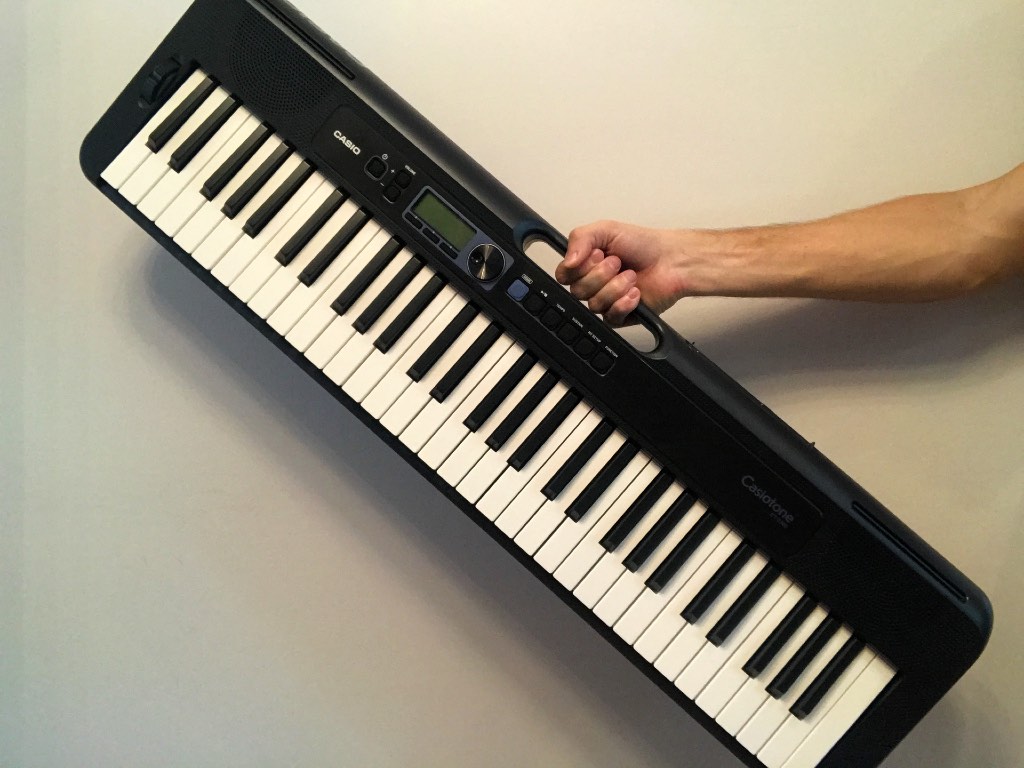 Casio first released its Casiotone keyboards way back in the eighties. Building on its promise to supply consumers with electronic pianos that anyone could afford, they recently revived this line with more modern features and updated models. I have received the CT-S100, 200, and 300 and spent quite some time exploring the various modes and options. Keep reading to find out if these digital keyboards with attractive price tags are right for you.
Casio first released its Casiotone keyboards way back in the eighties. Building on its promise to supply consumers with electronic pianos that anyone could afford, they recently revived this line with more modern features and updated models. I have received the CT-S100, 200, and 300 and spent quite some time exploring the various modes and options. Keep reading to find out if these digital keyboards with attractive price tags are right for you.
Here is a short video explaining the main differences between models and sound examples from the CT-S300.
Casiotone common features
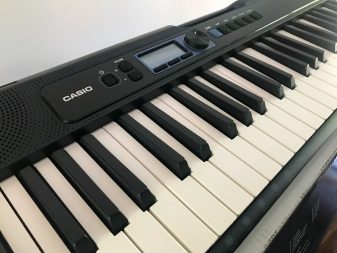 Whichever model you pick from the Casiotone keyboards, you will get a 61 note keyboard. Although this is not the full range of a regular piano, it is a pretty good compromise between range and portability. You will be able to play most of the world’s repertoire. The keys are also full sized, unlike some highly transportable options that exist. There is a minimum amount of weight on these keys, unlike an acoustic piano. Although this is great for playing synths, organs, and many other instruments, it’s not ideal to develop proper technique that will transpose easily to the conventional piano. In fact, many teachers insist on the weighted key feature. Make sure you consider this before purchasing your first instrument!
Whichever model you pick from the Casiotone keyboards, you will get a 61 note keyboard. Although this is not the full range of a regular piano, it is a pretty good compromise between range and portability. You will be able to play most of the world’s repertoire. The keys are also full sized, unlike some highly transportable options that exist. There is a minimum amount of weight on these keys, unlike an acoustic piano. Although this is great for playing synths, organs, and many other instruments, it’s not ideal to develop proper technique that will transpose easily to the conventional piano. In fact, many teachers insist on the weighted key feature. Make sure you consider this before purchasing your first instrument!
All three keyboards have the same plastic shell that sports a very useful handle. These keyboards are so light, you might find yourself carrying it around by the handle most of the time. I still recommend a case though, and Casio has the SC-50B, which can be carried around as a backpack: perfect! This handle also accommodates the music rest that comes with all three digital pianos.
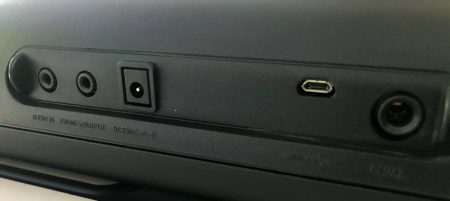 An adapter is included, but you can also power the keyboard using 6 AA batteries. This is really smart from Casio, because these models lend themselves really well for playing on the move. On the back, you’ll find an output for headphones and a USB plug. Unfortunately, the CT-S100 is the only model that’s incompatible with Casio’s learning app: Chordana. This is a shame, because the app is well built and helps you learn songs in an efficient manner.
An adapter is included, but you can also power the keyboard using 6 AA batteries. This is really smart from Casio, because these models lend themselves really well for playing on the move. On the back, you’ll find an output for headphones and a USB plug. Unfortunately, the CT-S100 is the only model that’s incompatible with Casio’s learning app: Chordana. This is a shame, because the app is well built and helps you learn songs in an efficient manner.
Sounds and features
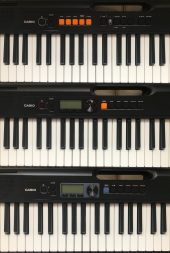
The entry model, in comparison to its siblings, is quite limited on the number of sounds. There are 122 different ones to play with, which is still a respectable amount of variety. But when you compare to the 400 available on the 200 and 300, it feels, irrationally, very small. The absence of an LCD screen on the base model makes switching sounds slightly different than most keyboards, so that might take some adjustment.
All three models have rhythms that you can use to accompany your playing. The 100 has 61 different rhythms, while the 200 and 300 have 77 of them. This feature is a lot of fun and will enhance your practice experience by making you feel like you are actually making music.
One of the big differences between the 100 and the 200/300 is the Dance Music Mode. This is actually a lot of fun and will develop your arranging and composing skills. It enables you to take a variety of instrument loops (drums, bass, and two synths), as well as a few different effects, and activate them at the press of a key. This is quite similar to what producers do with some digital audio workstations and sequencers.
I’ve had a very pleasant time trying out various combinations of instruments and parts to create my own jams. I think this feature will be a hit with younger users. If you are curious, there are two examples of me playing around in this mode in the video, so make sure to give it a listen.
The CT-S200 and 300 models
The LCD screen on the 200 and 300 models makes navigating easier, but it’s still a chore because of the amount of sounds to cycle through. There’s really a limited amount of buttons to help you navigate. Apart from the presence of a mod wheel, the huge difference between these two is the presence of touch sensitivity on the CT-S300. Depending on the amount of force you use to press on the keys, the sample that will be triggered will reflect your pressure. This means things will get louder the harder you play and vice versa.
Impressions
If you ever felt any sort of jealousy towards guitarists who carry their guitars along to the party and become the center of attention, now’s your chance to either compete or join forces. All three models are very easy to carry, and the built in speaker/battery powered combo really enables you to bring music to everyone, no matter the location.
The price of the Casiotone keyboards is very attractive and could incite a lot of beginning pianists to consider these models. If you do decide to go this route, I highly recommend the CT-S300 over the other two. In this day and age, I have yet to understand why companies make keyboards that aren’t touch sensitive. If you don’t have this feature, you are essentially cutting out dynamism in music. This really is a shame as it is part of the building blocks of music.
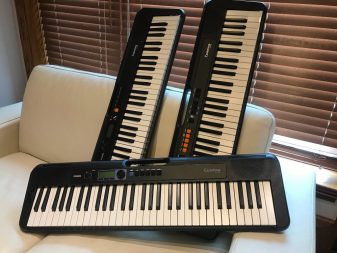
That being said, Casio conceived these models very well. You could definitely use them as a backup keyboard too. The variety of sounds and rhythms will serve you well and will cover you in most situations. The features are generous, and the Dance Music Mode is a fun activity to get your creative juices flowing. Also, if you have access to the Chordana App, you’ll be able to quickly learn the 50 built-in songs or import your own. A cool point system gamifies the whole experience, making it quite motivating to keep getting better and better. This is a great way of learning to play on your own or to supplement your lessons.
I’ve also recently reviewed the Casio CDP-S350, which might interest new players that are looking for the best bang for your buck with weighted keys and quality features.
Make sure you check out the Casio Casiotone keyboards (CT-S100, CT-S200 and CT-S300) on Best Buy’s website.

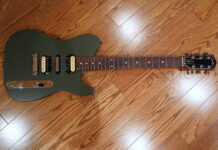

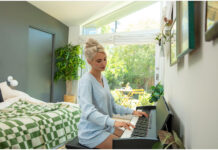
These keyboards are portable and provide good sound at an affordable price.
The mobility capability of the casiotone is a beautiful piece of art in the piano world.
The best feature is the fact that it is 100% portable
I like that it is light weight and I can carry it in my backpack
Nice review! I like that they are portable, as I would gift this to my nephew and my brother would appreciate him being able to take it to another room while he is learning! 🙂
I like the Casio keyboards are slim, light and portable.
Full-sized keys!
I love that this is lightweight and transportable! Great for a beginner pianist!
I like that these Casio keyboards are affordable!
This is a great gift for my granddaughter. I love that it’s great for beginners as well as being lightweight and portable. Thanks #BestBuy for the chance at a great prize!!
I love that they are lightweight, easily transportable and that most of the models have Casio’s learning app.
I like the portability of Casio keyboards.
Portability with full sized keys
I like the portability of Casio keyboards. Thanks for the opportunity.
Great prices and built in rhythm is awesome
I love that they can be battery operated
I love that they are light weight
I like the portability of Casio keyboards.
I really like the full size keys
I like the portability of Casio keyboards.
They are portable.
I like that it’s lightweight with an easy to carry handle
Comments are closed.